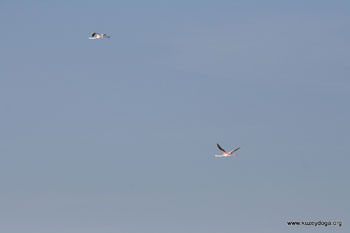Extreme temperatures are influencing birds

It is December, but Flamingos are still flying in mile-high Kars, Turkey. An ecological message from Turkey to the climate change conference in Cancun, Mexico.
Two flamingos (Phoenicopterus roseus) were photographed last week by the science coordinator of KuzeyDoğa Society, Emrah Coban at the Ramsar site of Lake Kuyucuk Wildlife Reserve. “These birds prefer warm to tropical climates and breed in warm regions of Turkey, so it was a surprise to see them in the winter in Kars, which has a Siberia-influenced weather similar to those of Russia, Montana or even Alaska” he says…
A flamingo was recorded at Lake Kuyucuk during migration season, September 2007 for the first time, while KuzeyDoga Society, Kafkas University and Kars Province Directorate of Environment and Forestry was carrying out bird ringing studies at the lake. Observing flamingos in Kars in winter (where temperatures can exceed -40 C) however, raised the questions about the effects of climate change. Winter flamingos in Kars sent an ecological message from Turkey to the floundering climate change meeting in, Mexico.
Covering 219 hectares, Lake Kuyucuk Wildlife Reserve is the only Ramsar site of Eastern Anatolia. The lake normally starts to freeze in November and stays frozen until April. However, on December 1 2010 it was 16ºC, far from freezing, and the lake was hosting over 10.000 birds of 13 different species. Among these, pink flamingos trying to hide in overgrazed reeds surprised the birdwatchers. Kars is a province with globally important wetlands. Lake Kuyucuk, with over 215 bird species, is an especially important lake where aquatic birds rest and almost half the bird species of Turkey are observed. As a result, it has been chosen Turkey’s 13th and eastern Turkey’s first Ramsar wetland.
Dr. Cagan Sekercioglu, president of KuzeyDoga Society and faculty member at University of Utah Biology Department stated:
“Although we cannot absolutely attribute seeing flamingos on Kars Kuyucuk Lake to climate change, seeing flamingos in Kars, especially in the winter, is not normal. Bird ringing and satellite tracking studies have shown flamingo movements between Turkey, North Persia, Middle East, Caspian Sea and India.”
Maybe, these birds were lost during migration…
There is a possibility that however, even if they were lost, if Kars was experiencing normal winter temperatures, these birds would have avoided the cold and would fly to warmer areas, rather than staying on the Kars plateau. However, offspring-like temperature of 16ºC enabled the flamingos, which prefer warmer regions and the tropics, to appear in Kars in the winter.
Why?
Because Lake Kuyucuk is freezing later, thousands of birds are still using it, instead of migrating to other regions. In fact, some migratory white storks greatly delayed their migrations this year and were also still around last week.
Could we say, “The East Anatolia Region is likely to become a refuge for some birds”?
Exactly… The East Anatolia Region which is colder than the rest of Turkey is likely to become a refuge for some birds species as climate change and global warming leads to extreme temperatures and droughts in other parts of Turkey. Therefore, it is more important than ever to protect, globally important wetlands like Lake Kuyucuk and to conserve the nature of Kars and other cool Eastern Anatolia provinces that are becoming ecological refuges for species experiencing the adverse effects of climate change and global warming.
Where do Flamingos live?
Flamingos live in flocks and usually prefer salty areas with standing water, soda lakes and lagoons. In Turkey, they are mostly seen in the Gediz Delta and Lake Tuz where they breed. Birds are among rare animals who can adjust their migrations according to the changes in the temperature.
Dr. Sekercioglu continues:
“Some of the most important indicators of climate change and global warming have been the changes in the dates and directions of bird migrations in response to the increases in temperature. Researchers determined that 75% of European bird species have declined because of global warming, but this study did not include Turkey due to the lack of data.”
Kars, Turkey and the world are warming, as temperature records are broken
During the past two weeks, coinciding with the Cancun Climate Change Conference, Kars experienced temperatures significantly above the seasonal averages. I did not know that, in the past 35 years, maximum average November temperature in Kars had been 6.4 °C. This year, however, Kars had an average temperature of 12.2 °C in November. Maximum temperature on December 1st was 16°C. “According to the General Directorate of Meteorology, this is far above the average value of 1.6 °C for that date. It was also a record, as the previous highest temperature recorded on December 1st was 9.4 °C. In the first week of December, maximum temperature records were broken every day” they say…
NASA is estimating that 2010 will be the hottest year ever worldwide. According to the United Nations, 2009 was a record-breaking year in carbon emissions. Carbon particles in the air increased by 1.6 ppm (particles per million) and reached 386.8 ppm. This is far above the “safe” level of 350 ppm that the global community should adhere to. Because carbon dioxide in the atmosphere traps heat (the greenhouse effect), increasing carbon dioxide emissions is among the most important factors that trigger global warming and climate change. According to the climate change modeling byTurkey’s National Science Council, TUBITAK, until the year 2040 the temperature inTurkey will increase by approximately 1.25 °C and rainfall will increase by 5% to 15%. The Eastern Anatolia Region, whereKars is located, will be the region where the differences in seasonal temperatures will increase the most.
(Turkish Journal)



